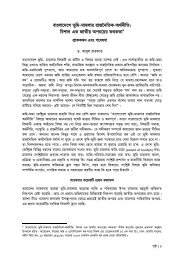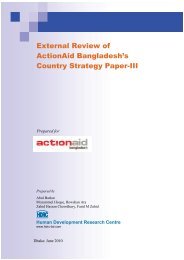08. Costing Essential Services Package An Issue Paper
08. Costing Essential Services Package An Issue Paper
08. Costing Essential Services Package An Issue Paper
You also want an ePaper? Increase the reach of your titles
YUMPU automatically turns print PDFs into web optimized ePapers that Google loves.
<strong>Costing</strong> <strong>Essential</strong> <strong>Services</strong> <strong>Package</strong>: <strong>An</strong> <strong>Issue</strong> <strong>Paper</strong> 19<br />
entirely line expenditures rather than service based commodity expenditures (as in the case of<br />
PPC estimates), it is difficult to assess the extent to which service costs are reflected.<br />
HEU’s ESP Cost Model was designed to be dynamic. In this connection, HEU authors<br />
recognize lack of relevant data on local level delivery of ESP and staff work patterns as the<br />
major areas of knowledge-gap to be fulfilled in the future.<br />
The HEU’s ESP costing exercise was done to satisfy the purpose of formulation of a simulation<br />
model using which cost dimensions of changing situation could be estimated. The utility of<br />
HEU’s simulation model is unquestionable. But, from the view point of its utility as ESP costing<br />
exercise there exist ample scope for improvement. Some of those are listed below:<br />
1. Since, the top-down procedure followed was based on project proforma-based costing, the<br />
total ESP expenditure is likely to be upward biased. The upward bias is partly attributable to<br />
the “cushion effect” of high side estimates on commodity, contingency and unforeseen<br />
elements in the PP. Just as an example, costs of reproductive health care (RHC), according<br />
to HEU is Tk.5025 million and the same according to PPC is Tk.2574 million. PPC’s<br />
estimate for RHC is less than HEU’s because the share of ESP expenditure in the non-ESP<br />
components is not included in the PPC’s estimate. The upward bias can be minimized by<br />
identifying the areas of bias and removing those using expert judgement and findings of<br />
available surveys.<br />
2. Although the model was designed as a simulation one, utility would be limited since optimal<br />
input combinations or resource requirements for any output were not considered.<br />
3. The fixed costs and super-fixed costs relating to the major areas and sub-areas of ESP are<br />
not appropriately apportioned. Such apportionment is needed to estimate unit cost which is<br />
essential for various useful purposes (discussed in section 5.1).<br />
4. HEU did not consider the possible impact of pay scale implementation on costs. Impact of<br />
pay scale needs to be considered.<br />
5. Costs by major sub-areas and conditions of ESP (shown in Figure 2) are not available.<br />
Appropriate measures need to be undertaken to disaggregate cost by major ESP areas<br />
(RHC, CHC, CDC, LCC, BCC) by sub-areas, sub-sub-areas, conditions and sub-conditions<br />
(as shown in Figure 2)<br />
5.3. <strong>Costing</strong> of various dimensions and major areas of ESP:<br />
Survey-based studies<br />
While the PPC (Section 5.1) and HEU studies (Section 5.2) were intended to provide estimates<br />
of comprehensive costing of ESP for the nation as a whole, many detailed and in-depth studies<br />
were undertaken mostly during 1995-1999 period to deal with the various specific dimensions<br />
and areas of ESP. The notable ones were conducted by D Balk et.al. (1988), B Janowitz et.al.<br />
(1996,a,b), B Rahman et.al. (1996), A Barkat et.al. (1996), K Streatfield et.al. (1997), A Barkat<br />
et.al. (1999), Rannan-Eliya and Somanathan (1999), and T Ensor (1999).<br />
“<strong>An</strong> analysis of costs and cost-effectiveness of the family planning – health services project in<br />
Matlab, Bangladesh” conducted by Balk et.al. (1988) is one of the initial studies that took place<br />
in Bangladesh. The basic methodology of the costing exercise to identify the key costs of<br />
service delivery and to estimate the full cost is interesting. Balk et.al. (1988) have illustrated the<br />
costing scheme as a service of concentric rings divided into two broad rings – core service






